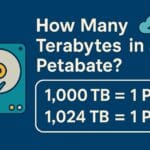Now Reading: How Many Terabytes in a Petabyte? (And Why You’ll See Two Different Answers)
-
01
How Many Terabytes in a Petabyte? (And Why You’ll See Two Different Answers)
How Many Terabytes in a Petabyte? (And Why You’ll See Two Different Answers)

If you’ve ever argued with a teammate (or your storage vendor) about how many terabytes in a petabyte, I’ve been there. The confusion hits when dashboards say one thing and invoices say another—suddenly that “simple” conversion turns into a rabbit hole. The quick, practical answer you need depends on whether you’re using decimal (SI) or binary (IEC) units. Let’s make this crystal clear and keep your estimates—and expectations—on point.
What’s the quick answer to “how many terabytes in a petabyte”?
Short answer:
- Decimal (SI, what most vendors use): 1 petabyte (PB) = 1,000 terabytes (TB).
- Binary (IEC, what many OS/file systems imply): 1 pebibyte (PiB) = 1,024 tebibytes (TiB), which is often loosely described as 1 PB = 1,024 TB (but strictly speaking, that’s mixing systems).
Why two answers? The metric system (SI) scales by powers of 10, while the computing world historically used powers of 2. To end the ambiguity, the IEC introduced separate names (tebi, pebi, etc.) for the binary versions.
How many terabytes in a petabyte (decimal vs binary)—which one should you use?
If you’re reading a cloud storage price sheet, drive spec, or vendor quote, you’re almost certainly in decimal: 1 PB = 1,000 TB. That aligns with SI prefixes that define peta as 10¹⁵ and tera as 10¹².
If you’re looking at operating system readouts, file systems, or backup software “under the hood,” you’ll encounter binary math. There, the precise unit is 1 PiB = 1,024 TiB (2⁵⁰ bytes vs 2⁴⁰ bytes). Many blogs still say “1 PB = 1,024 TB,” but the rigorous, standards-based way is PB/TB for decimal and PiB/TiB for binary.

Why does the “PB vs PiB” detail matter in real budgets?
Because a 10–12% swing at petabyte scale isn’t pocket change. One PiB equals about 1.1259 PB (decimal), so if you accidentally mix terms, your capacity or cost projections can be off by ~12.6%. That difference comes straight from the IEC vs SI definitions.
How to convert like a pro: how many terabytes in a petabyte for your use case?
Let’s build a quick mental model you can reuse in specs, dashboards, and spreadsheets.
- Pick your system first
- Need vendor apples-to-apples? Use decimal: 1 PB = 1,000 TB.
- Need OS/file-system accuracy? Use binary: 1 PiB = 1,024 TiB.
- Don’t mix symbols
- PB/TB/GB = decimal.
- PiB/TiB/GiB = binary (IEC).
- When you see “1 PB = 1,024 TB” online
- Treat it as shorthand rooted in legacy usage; if precision matters, restate it as 1 PiB = 1,024 TiB or compute both decimal and binary figures. Tools and reference charts often show both to reduce confusion.
How many terabytes in a petabyte for common scenarios?
- Drive/vendor specs & cloud pricing: Assume 1 PB = 1,000 TB unless the document explicitly uses binary prefixes. This is consistent with SI.
- Filesystem capacity planning (ZFS, XFS, NTFS, etc.): Be ready to see binary-style reporting and use PiB/TiB to avoid “missing capacity” surprises.
- Learning resources and glossaries: Many still say “1 PB = 1,024 TB,” reflecting the binary tradition; just map that to PiB/TiB mentally for precision.
What’s the exact byte math behind “how many terabytes in a petabyte”?
- Decimal:
- 1 PB = 10¹⁵ bytes
- 1 TB = 10¹² bytes
- Therefore 1 PB = 1,000 TB. (SI prefixes define peta and tera at these powers of 10.)
- Binary:
- 1 PiB = 2⁵⁰ bytes
- 1 TiB = 2⁴⁰ bytes
- Therefore 1 PiB = 1,024 TiB. (IEC binary prefixes formalize this.)
How many terabytes in a petabyte: do real-world tools disagree?
Yes—and that’s normal. Calculators and glossaries often present both systems side-by-side:
- Example: A converter may show 1 PB = 1,000 TB (SI) and also 1 PB = 1,024 TB (binary), highlighting the historic dual usage. Treat that second line as “PiB/TiB in spirit,” even if the symbols aren’t shown.
Frequently Asked Questions
1. Which is “correct”: 1,000 or 1,024?
Both are “correct” in their own systems. Use 1,000 when following SI/decimal (most vendor specs). Use 1,024 when following IEC/binary (OS/file-system math), ideally written as PiB/TiB to be precise.
2. Why do operating systems show smaller numbers than the drive box?
Your drive label likely uses decimal (PB/TB), while the OS often measures in binary (PiB/TiB). The same bytes are being counted with different rulers, which creates a visible gap.
3. Is a petabyte bigger than a pebibyte?
No. A pebibyte (PiB) is bigger: 1 PiB ≈ 1.1259 PB. That ~12.6% difference is why precise terminology matters at scale.
4. What should I write in documentation to avoid confusion?
Pick one system and stick to its symbols. If you must mix contexts (e.g., vendor PB vs OS PiB), include both values with their correct symbols and a one-line note on the SI–IEC difference.
So, how many terabytes in a petabyte—what’s my bottom line?
Use 1 PB = 1,000 TB for vendor specs, pricing, and quick estimates; switch to 1 PiB = 1,024 TiB for system-level accuracy. When in doubt, label units clearly and avoid mixing PB/TB with PiB/TiB. Your capacity plans—and your budget—will thank you.















